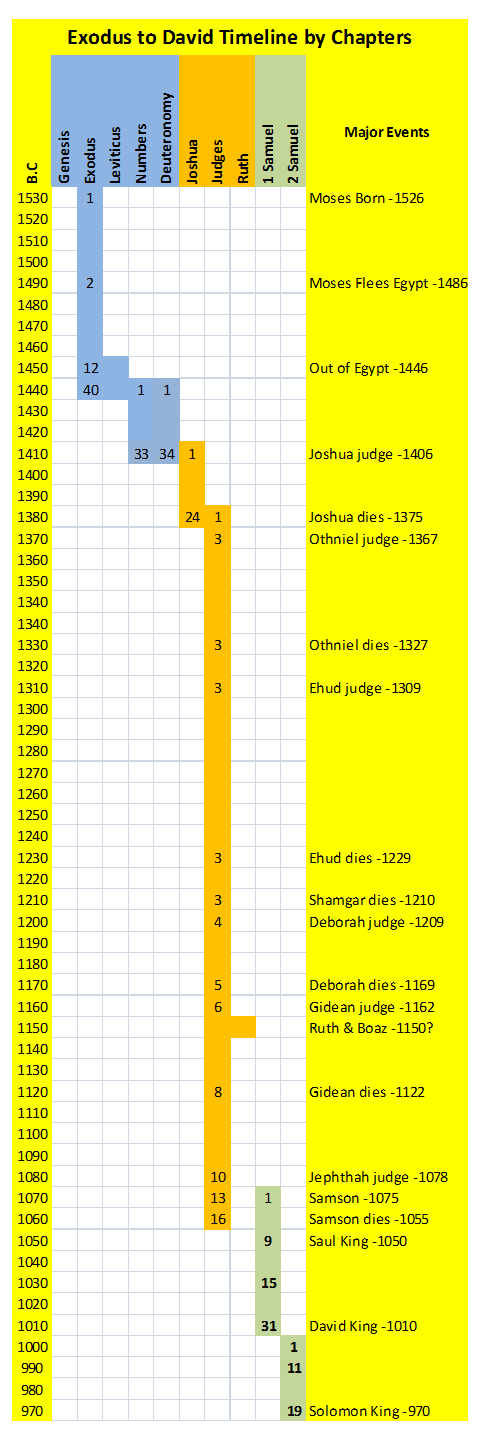INTRODUCTION TO 1 AND 2 SAMUEL
Irvine L. Jensen
The Moody Bible Institution of Chicago
copyright © 1968
Used by permission.
QUESTIONS TO STUDY ONE
OUTLINE
MAP OF THE UNITED KINGDOM OF ISRAEL
ISRAEL'S HISTORY
LIST OF ISRAEL'S KINGS AND PROPHETS
Before analyzing the text of any book of the Bible, it is well to learn the historical background.
Also, it is best to make a "skyscraper" view of its general contents. Accordingly, this introduction is divided into two parts: background and survey.

- STUDY HELPS
- The word kingdom is an important word in the Bible. This is evident by its frequent usage by Jesus in the Gospels. Since the kingdom of God, the kingdom of heaven, and the everlasting kingdom are for the children of God, they should be acquainted with what the Bible teaches about the subject.
- The books 1 and 2 Samuel records the history of the beginnings of the kingdom era of Israel, including the kingdom of David, a type of Christ's kingdom. May this study guide help you see the highlights of that era and their significance in the total plan of God. Beyond that, may you learn valuable spiritual lessons for your own Christian experience.
- Incorporated in this study are various helps on analyzing the Bible chapter by chapter and paragraph by paragraph.
- These lessons may be used either for individual or group Bible study. When several are studying together it would be well to have a leader.
- The leader should observe the following suggestions:
- If any lesson seems too long for one meeting, use half the assigned work and leave the other half for the next meeting. Undertake no more than the class can do thoroughly.
- If possible, use enlarged copies of the map and major charts appearing in this book at the appropriate class meetings.
- Insist that as far as possible members of the class study the lesson at home and bring to the class written answers to the printed questions.
- Briefly review the previous work at the beginning of each meeting.
- Insist that the members of the class think and study for themselves. Give them opportunity to express their thoughts and tell the lessons they have learned. Refuse simply to lecture to the class.
- Constantly emphasize the importance of carefully looking up all Scripture references given in each lesson. This should not be neglected.
- HISTORICAL THOUGHTS TO CONSIDER
- The book called 1 Samuel follows Judges and its companion Ruth appropriately, for it continues the history of Israel from the point Judges leaves it.
In the study of the book of Judges we saw Israel's repeated departures from God and the complete failure of the nation to conform to the ways of God in either worship or government. The book ends in utter confusion religiously and politically, with every man doing "that which was right in his own eyes" and with no sense of authority in the land. The last verse states, "In those days there was no king in Israel." That is, no man was the head of the nation, no voice commanded the obedience of the people, no prince served as commander-in-chief of all the tribes at one time in a nationwide program to subdue the enemies, and no one monarch unified the people under the banner of their sovereign Lord God.
It was always God's purpose to reign as King in the lives of the Israelites. A government so ordered is called a theocracy (from the Greek theos, "God"). Furthermore, in terms of organization, God desired to preserve the unity of His chosen people through the leadership of one ruler over all. That is what is called monarchy (from the Greek monos, "one"). God's design, therefore, called for the combination theocracy-monarchy (theocratic monarchy, or monarchic theocracy).
The years of the judges were years of spiritual decline for Israel, because the nation was increasingly putting God out of their lives. Thus they were not theocratic. When the time came (1 Sam. 8) that they felt their need for a king (monarchy), they had rejected the idea of God on the throne (theocracy). God objected to their request for a king not because He was against kings (monarchy) but because of their rejection of Him (theocracy): "They have rejected me, that I should not reign over them" (1 Sam. 8:7).
God granted Israel kings but not without warning of consequences for dethroning Him as their King. Then, in His mysterious workings of grace and might, as God of history He used the people's kings as His channels of revelation, service, blessing, and justice. One of those whom He anointed as king was David, a "man after His own heart," who would be the grand type and forerunner of the messianic King. The two books of 1 and 2 Samuel describe the establishing of this Davidic kingdom in Israel.
It will be of help to you as you begin your study of 1 Samuel to see its place among the Old Testament books that describe Israel's history. Broadly speaking, the history of Israel as given in the Old Testament falls into four periods that may be remembered by four words, each beginning with the letter C, Camp, Commonwealth, Crown, Captivity.
- The Camp period extended from the call of Abraham, the founder of the nation, to Moses' bringing the people up to the "gate" of Canaan, a period of about 660 years, the history of which is given in the Pentateuch.
- The Commonwealth period extended from their entrance into Canaan under Joshua to the crowning of their first king, Saul, ' a period of about 360 years, the history of which is given in Joshua, Judges, and Ruth.
- The Crown period extended from the crowning of their first king, Saul, to the Babylonian captivity, a period of about 460 years, the history of which is given in the six books of Samuel, Kings, and Chronicles.
- The Captivity period, including the restoration, extended from the Babylonian captivity to the end of Old Testament history, a period of about 160 years, the history of which is told in Ezra, Nehemiah, and Esther.
- You will find interesting descriptions of these periods of Israel's history in Psalms 78 and 79, as follows: under Moses, Psalm 78:5-54; under Joshua, Psalm 78:55; under the judges, Psalm 78:56- 64; under the kings, Psalm 78:65-72; in captivity, Psalm 79:1-13.
- BACKGROUND
At the very outset of our study these are some of the questions that come to mind: Who wrote the book? When did he write it? What was his main object? What is the historical setting? How does the book serve a particular function in the entire Bible? The answers to these and other questions are given briefly below.
- Title. Samuel is one of the main characters in the story of 1 and 2 Samuel and may have been one of the authors of the books. Why was his name rather than the name of one of the other main characters chosen for the title? This may partly be explained by the fact that Samuel was the key character of 1 Samuel, and it was he who anointed the two other main characters, Saul and David, to be king. Add to this the high esteem in which he was held by the Jews who attached titles to the Bible books (the titles were not part of the original autographs). "Among the Jews he was regarded as a national leader, second only to Moses. As Moses delivered Israel from Egypt, gave them the law, and brought them to the very borders of the promised land, so Samuel was sent of God to deliver Israel when the nation's fortunes seemed almost hopeless. Spiritually and politically, the nation appeared virtually lost at the end of Eli's judgeship (cf. 1 Sam. 4:12-22; Ps. 78:59-64; Jer. 26:6). Under Samuel came a wonderful spiritual renovation and a new hope (1 Sam. 7).
- Place in the Canon. In the modern Bible 1 and 2 Samuel appear among the historical books. The earliest Hebrew Bibles considered the two books as one, among the Former Prophets (Joshua, Judges, Samuel, Kings). Notice the change of titles made over the years:
- Hebrew Bible (B.C.): Samuel; Kings
- Septuagint (B.C) 1,2 Kings; 3,4 Kings
- Vulgate (A.D.): 1,2 Kings; 3,4 Kings
- Modern Bible (A.D.): 1,2 Samuel; 1,2 Kings
- Author and Date. It is difficult to identify the author, or authors. Samuel could only have narrated the events that preceded his death (recorded in 1 Sam. 25). (That Samuel was a writer of at least one work is indicated by 1 Sam. 10:25.) Various suggestions of authorship or co-authorship include Abiathar, an attendant of David; Nathan and Gad ~ (d. 1 Chron. 29:29); and pupils from Samuel's school of the prophets. The detailed and vivid account of the happenings, with which these books abound, indicates that most of the narrative was written by men living at the time these things occurred rather than that the authors lived at a much later date.
The fact of joint authorship does not take away from the unity of the book as to its theme. Concerning all the writings of Scripture, one must continually recognize the supernatural moving of the Holy Spirit in the human writers, whoever and however many they were, to compose the holy writings.
Granting the possibility of Samuel's being one of the authors, the two books 1 and 2 Samuel were written some time between 1025 and 900 B.C.
- Purposes. Three main purposes of 1 Samuel may be cited:
- Historical
- To furnish a record of the transition from the era of judges to that of the monarchy (read Acts 13:20-21, noticing these three words: judges, prophet, king).
- To describe the influences of Samuel upon the life of Israel and upon many of their leaders
- To furnish a setting for the reign of David as described in 2 Samuel
- Time line B.C. (from NIV Study Bible)
- 1105 -Birth of Samuel (1 Sam. 1:20)
- 1080 -Birth of Saul
- 1050 -Saul anointed to be king (1 Sam. 10:1)
- 1040 -Birth of David
- 1025 -David to be Saul's successor (1 Sam. 16:1-13)
- 1010 -Death of Saul and beginning of David's reign over Judah in Hebron (2 Sam. 1:1; 2:1,2,11))
- 1003 -Beginning of David's reign over all Israel and capture of Jerusalem (2 Sam. 5)
- 997-992 -David's wars (2 Sam. 2:1-14)
- 991 -Birth of Solomon (2 Sam. 12:24; 1 Kings 3:7; 11:42)
- 980 -David's census (2 Sam. 24:1)
- 970 -End of David's reign (2 Sam. 5:4-5; 1 Kings 2:10-11)
- Typical or Symbolical
The books of Samuel are rich in typical, or symbolical, truths. In many ways this Old Testament book foreshadows Christ in His offices of prophet, priest, and king. In this history of the kings of Israel we see how utterly incapable man is of governing himself. The Bible and human history convince us that what the world needs is the universal reign of an Absolute Ruler who shall have infinite love, wisdom, and power. Such a Monarch is coming and, we believe, coming soon. But we are told in Scripture that before the true King comes there must come the Antichrist who, in the power of Satan, shall rule for a time. The establishing of the kingdom in Israel prefigures all this. David is a type of Christ; but before David comes Saul.
- Spiritual
First Samuel shares this spiritual purpose with all Scripture. You will learn many spiritual lessons from this book. Among them is what is taught about prayer. Take time out now to look up these references: 1 Samuel 1:10-28; 7:5-10; 8:5-6; 9:15; 12; 19-23; 28:6.
- The Man Samuel. The name Samuel is from a Hebrew word that has been variously translated as: "the name of God," "his name is God," "his name is mighty," or "heard of God."
One is not surprised that the Jews have esteemed Samuel second to Moses among their leaders. The psalmist (Ps. 99:6), and God speaking to Jeremiah (Jer. 15:1), classified Samuel with Moses as an interceding priest. Samuel held the honor of being the last of the judges (1 Sam. 7:6, 15-17) and the first of the new order of prophets (1 Sam. 3:20; Acts 3:24, 13:20). The stature of the prophetic office during the years of the kingdoms can be traced back to the life and ministry of Samuel. He probably was the founder of the school of prophets (1 Samuel 10:5).
Samuel was a giant among the men of God in biblical times.
He lived to serve God, not to save himself. He knew without reservation that following the Lord with all the heart was the highest calling of any man or woman, boy or girl. He was holy and humble and kind. He sought not his own good but always the good of others. And when the day came for him to turn the reins of leadership over to another, he did it with grace and paternal commendation.
- Some Distinctive Points of 1 Samuel. First Samuel contains many unique items. Some of them are:
- It is the source of the oft-quoted words "Ichabod" ("the glory is departed" or "where is the glory?"), 4:21; "Ebenezer". ("hitherto hath the Lord helped us"), 7:12; and "God save the king" (10:24).
- The word of the Lord is referred to as "precious" (3:1). Recall other things cited by the Bible as precious, such as: redemption (Ps. 49:8), death of the saints (Ps. 72:14; 116:15), God's thoughts (Ps. 139:17), and lips of knowledge (Prov. 20:15).
- Reference is made to the school of the prophets, probably founded by Samuel (10:5; 19:18-24).
- It is the first Old Testament book to use the phrase "Lord of hosts" (appears eleven times in the two books of Samuel: e.g., 1 Sam. 1:3).
- Like the book of Judges, explicit reference to the law of Moses is lacking. But many of the items and activities inherent in the law (offerings, Tabernacle, Ark, Aaron, Levites, etc.) appear frequently.
- An important place is given to the Holy Spirit and (as noted earlier) prayer.
- In the early chapters much light is shed on Shiloh as the focal place of the national religion.
- SURVEY
- Now that you have seen something of the background of this book and have noted some of its highlights, you are ready for a "skyscraper" view of its composition as a whole. Such an acquaintance will help you learn the overall structure of the book for a point of reference in your later analytical studies of the various smaller parts. By way of illustration: a tourist visiting New York City for the first time would do well to view the city first from the top of the Empire State Building before going down and moving about the labyrinth of streets, subways, buildings, and parks.
- Survey study is basically composed of two activities: reading and recording. Use the following guides:
- Before you begin to read, notice each chapter of the book. Make a note in your Bible that extra segments begin at 2:11 and 21:10; and that 4:1b, 7:3, and 28:3 replace 4:1, 7:1, and 28:1 as starting points.
- With pencil or pen in hand, begin reading the book. You need not read every word of each chapter, but you should read enough so that you know the general content of each chapter.
1. Frances Davidson, ed., The New Bible Commentary (Grand Rapids: Eerdmans, 1953), pp. 262-63.
STUDY 1 QUESTIONS
STUDY 1 COMMENTS
|























